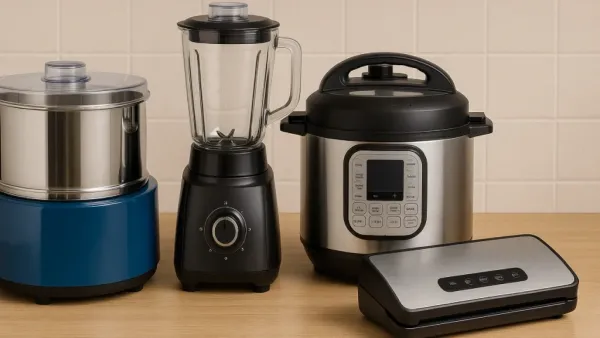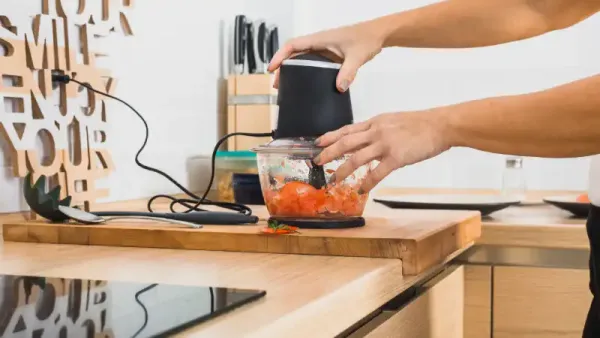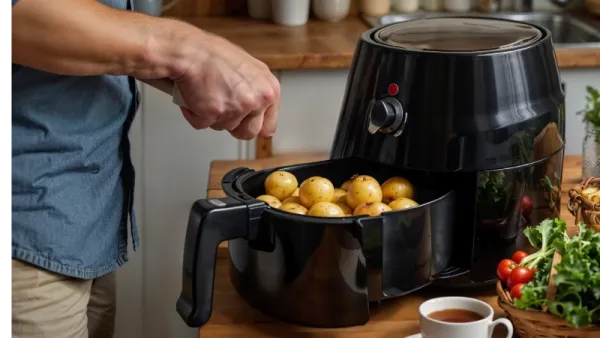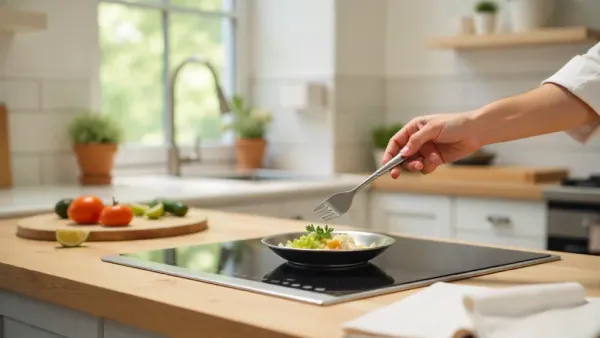
Indian cooking is rich in procedure and frequently labor-intensive, and contemporary kitchen gadgets can eliminate friction without losing the flavors and textures that characterize desi cuisine. The optimal equipment for grinding, measuring, heating, fermenting, and preserving never replaces your skill; it makes it replicable and consistent. They convert unreliable fermentation into reliable idlis, lower the chance of burnt tadka, and hasten prep for complex meals without sacrificing authenticity.

This article looks at functional products and developing technologies that have become truly useful in Indian kitchens, keeping in mind grinders and blenders, precision heat and timing instruments, steam and fermentation assistants, multi-functional devices, ventilation and oil management, and preservation systems that enable busy cooks to hold on to tradition in a weekday routine.
A great wet grinder is still the key to the dosa and idli lovers of today, and the Elgi Ultra Grind+ and the Premier wet grinders of the contemporary market are the ones that have become the most recognizable for their stone grinding reliability, low-noise motors, and compact footprints that fit perfectly in city kitchens.
The Elgi Ultra Grind+ maintains the stone action that incorporates air into the batter while also offering better noise insulation and a sturdy stainless steel drum, making the entire cleaning process very easy. For groups needing quick, smooth blending with paste work, the Sujata Powermatic mixer-grinder and the Philips ProBlend or Avance series blenders can make all coconut chutneys, spice pastes, and ginger-garlic mixes with variable speed and heat-resistant, durable jars.
The spice lovers who want to ensure the top-note aromas of their spices will need to use a special spice grinder like the Bajaj Rex or low-heat-transfer small burr grinders; these are able to keep the aromas of cardamom, coriander, and cumin when they are ground into powders instead of reducing them to flat and dull through overheating..
The benefit of these devices is not a hidden one: they are revealed by the smoother batters, livelier chutneys, and the masalas that are able to release their flavor and not get burnt.

Control over temperature revolutionizes the behavior of much Indian cooking, and induction stoves from Pigeon and Prestige with accurate simmer controls and quick response are now a part of kitchens that seek replicable tadka and reduction under control. Prestige induction models with separate simmer presets allow you to handle ghee and tempering without desperate flame-juggling. At the same time, compact single-zone burners provide stovetop space for other uses during festival cooking.
Sous‑vide immersion circulators like the Anova Precision Cooker and small footprint models have a niche for low‑temperature marinades and kebabs; cooking kebabs or marinated paneer in a bath of water results in even doneness, and finishing on a tawa becomes quick and consistent. More recent, innovative induction hobs with Wi‑Fi and recipe integration are also becoming popular: they allow you to define temperature profiles based on phone recipes and ensure uniform heat for multi‑step dishes, taking much of the seasonality out of previously defined fermentation and simmering steps.
Repeatability in Indian cooking is as much a matter of measurement as feel, and a precision kitchen scale from Tefal, Kenwood, or a reliable domestic brand makes batter hydration and sugar syrup stages consistent. Instant-read and probe thermometers like Meater, or a trusted K-type digital probe, are a godsend for candy stages and oil temperature, helping jalebi achieve the proper thread and pakoras fry at a perfect heat so they never end up oil-sodden.
Programmable digital timers and Bluetooth kitchen timers that connect to recipe apps make coordinating dal simmering, rice steaming, and snack frying easier, particularly for cooks who are handling several dishes at once. These measuring aids convert gut feelings into reliable results and are usually the most effective improvement for cooks seeking dependable festival and weekday results.
Steaming and fermentation are also at the heart of most local cuisine, and electric idli cookers and multi-tier steamers from Prestige and Butterfly now feature improved water management and non-stick plates that yield even idlis and dhoklas. Temperature‑regulated fermenters and proofing boxes are becoming convenient appliances for households that find seasonal fluctuations in batter rise problematic; compact fermenters that maintain a constant 30–35°C eliminate the need to hunt for warm spots during winter and ensure consistent fermentation throughout the year.
Steam ovens and combi steam units, although more expensive, provide extremely even steam distribution for sensitive foods such as modaks and momos and are being found in more aspirational home device kitchens where budget and space allow.
These modern appliances can turn many tedious, time-consuming processes into a single machine. The Instant Pot family of appliances remains the best choice for pressure cooking, slow cooking, sautéing, and making yogurt, with Indian-friendly settings for rajma, chana, and khichdi. Bosch and Philips food processors equipped with attachments for kneading, shredding, and slicing speed up prep for onions, grated coconut, and kneaded atta, and drastically cut paratha and stuffed roti prep times.
Air fryers from Philips, Havells, and Bajaj now include accessories and basket sizes tailored for Indian snacks, delivering crisp pakoras and kebabs with less oil while maintaining the expected textures. Working with these appliances means that the kitchen spaces remain small and, as a result, the sophisticated weekly menus can be sustained without continuous monitoring of the stove.
Control of smoke and airborne oil is essential in desi kitchens, and contemporary auto‑clean chimneys from Elica and Faber minimize grease buildup and maintenance time by using heat‑based or filterless cleaning systems. Tabletop extractors and magnetic vent attachments offer convenient alternatives in smaller apartments or rental kitchens, greatly reducing the residual smell and oil film that previously contributed to cabinet and exhaust system wear.

For effective frying, calibrated oil dispensers with anti‑drip spouts and splatter guards prevent waste and mess, maintain consistent frying temperatures, enhance snack quality, and save cleaning time.
AmazonBasics and local-branded vacuum sealers are suitable for chutneys, marinated proteins, and batters, as they reduce oxidation and prevent freezer burn, enabling batch cooking and seasonal storage. Humidity-controlled, airtight modular containers keep staples like rice, dal, and flour free of bugs in wet climates. At the same time, blast-cooling methods or shallow, rapid-cool trays preserve the color and texture of par-cooked vegetables for reheating.
Smart fridges with humidity-controlled crisper drawers and herb containers prolong the life of coriander, curry leaves, and green chilies, small details that improve finishing flavors throughout the week.
The last few years have brought kitchen technology that combines convenience with AI and connectivity. Recipe-savvy smart ovens and app-connected induction hobs are starting to offer guided cook modes that automatically adjust temperature and time based on a scanned recipe, making it easier for less skilled cooks to prepare multi-step desi dishes with more confidence.
Hybrid vacuum-sous vide appliances that integrate sealing and low-temperature baths streamline meal prep in today’s homes. Auto-dispensing spice grinders and digitally regulated masala roasters that minimize operator inconsistency are specialized but new equipment in test kitchens and cloud kitchens. Even small appliances such as IoT-enabled fermentation tanks and app-connected steamers are now more widely available, injecting industrial consistency into domestic cooking.
The most intelligent kitchen gadget decisions are those that follow recurring issues: inconsistent fermentation, uneven tadka, smoky kitchens, and lengthy prep times.

Buying the right equipment can be regarded as a practical investment since the kitchen will be perfectly equipped: a Premier or Elgi wet grinder for batter, a Sujata or Philips blender for making pastes, a Prestige induction stove for heat control, an Instant Pot for sequential cooking, an Elica chimney to eliminate smoke and a vacuum sealer to keep food fresh – each of these pieces of equipment addresses the most common silkiness issues without compromising the authenticity of the dish.